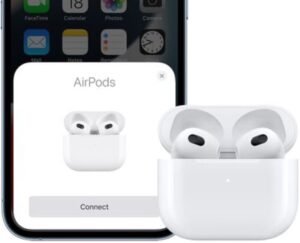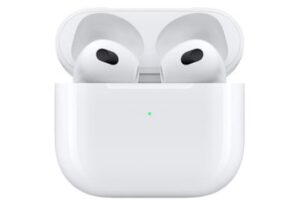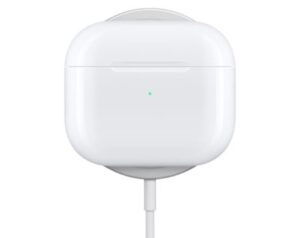Apple Air Pod
Afsana Akter
Pamela Stenberg
Hostos Community College
8th March 2022
Apple AirPod
Introduction
Apple Inc., based in California, is a well-known innovation company specializing in phone production and the development of other private technologies such as computers, headphones, televisions, tablets, watches, and media players. Apple’s mission statement states that the company creates MacBook, the finest computers worldwide, OS X, iLife, iWork, and specialized software for businesses. Apple’s iPods and iTunes online store led the current music insurgency. Apple has redefined the mobile phone with the iPhone and App Store, and the iPad is clarifying the development of media and computing gadgets. This mission statement differs significantly from that of the company’s founder in that it emphasizes innovation instead of the company’s strategies and objectives. Apart from their mission statement, Apple Inc.’s website highlights their values, including accessibility, training, the surroundings, inclusion, diversification, confidentiality, and supplier soundness (Amorim, 2017). Regardless of the lack of consistency between its values and its mission statement, Apple Inc. is known for constantly improving its products by releasing new upgrades that keep up with consumer demand.
Apple released the Air Pods in 2016. Apple Air Pods are a pair of wireless headphones that can be used with iPhones, iPods, MacBook, and Apple Watches. This item consists of two white headsets that are magnetically connected to a white pod-like charger for charging and storage. Apple Inc. had previously developed wire headsets that were more akin to those used in the past (Amorim, 2017). Along with the iPod, Apple Inc. released an elegant white headphone in 2001, setting them apart from the competition. Just after the launch of the iPhone in 2007, Apple Inc. released a new headphone that came standard with all iPhones and included a volume control and microphone. In 2008, Apple released the headphones to recreate the headphone (Gilmore, 2019). These headphones had the same appearance as the others, but they included the detachable gel piece found on most headphones designed to fit snugly in the ear. After this, Apple Inc. released a new update in 2011 that included Siri voice control that could be initiated via the microphone. The EarPods were introduced in 2012 as yet another upgrade to the headphones. These headphones had a new design that improved the audio experience by molding the human ear while maintaining the stylish white color. Then, in 2016, Apple Inc. released the groundbreaking Air Pods (Gilmore, 2019). The Air Pods are magical because they are wireless, easy to use, and magical. These qualities are reflected in their AirPod marketing campaign. The Air Pods were first advertised in a commercial called Stroll.
Internal hardware
A custom high-excursion driver and an extended frequency series amplifier combined in the Air Pods to produce powerful bass and precise high frequencies is outstanding. These features are also found in Apple’s Air Pods Pro. Mesh-covered dual beamforming microphones reduce wind and ambient noise, ensuring that your voice is heard clearly on the other end of the line, and AAC-ELD support ensures full HD audio quality for FaceTime calls.

Figure 1: Internal hardware
https://www.macrumors.com/roundup/airpods/
H1 Chip
The H1 chip in the Air Pods 3 is the same one used in previous generations of Air Pods. The H1 chip enables one-touch bonding and fast gadget swapping with Apple devices, as well as attributes such as Audio Sharing, which allows you to connect two sets of Air Pods to apple device (Amorim, 2017). The Air Pods will immediately shift around the apple devices as you are using them, removing the need for Bluetooth controllers to switch gadgets.

Figure 2: H1 chip
https://www.macrumors.com/roundup/airpods/
Skin detect sensor
Air Pods have a newfangled skin-detect beam that detects whether Air Pods are inside the user’s ear, in a pouch, or on the desk, pausing play when the Air Pods are out of the ear.
Siri support
Siri can control the volume, change the song, make calls, and more about the “Hey Siri” instruction, facilitated by the H1 chip. In iOS 15, Siri could also notify received alerts and tell you what messages suggest when you get them (Amorim, 2017). Siri functions similarly to any other gadget, and the voice assistant can respond to a variety of questions and execute activities such as changing the volume on the gadget.

Figure 3: Siri support
https://www.macrumors.com/roundup/airpods/
Sound Quality
The Air Pods have a Dynamic EQ attribute that enhances audio quality by taking into consideration the form of each person’s ear. Dynamic EQ uses machine learning music and an inner microphone towards the ear to provide a proper audio resume for every person wearing (Linden et al., 2011). The Air Pods continuously adapt and tune the low to middle frequencies to compensate for whatever could be vanished due to fit distinctions. The audio is tailored in reality premised on the apt of the AirPod in the customer’s ear.

Figure 4: AirPod design
https://www.macrumors.com/roundup/airpods/
MagSafe charging case
Apple has created a MagSafe Power Bank alongside the AirPods 3 that can magnetically connect to MagSafe cables. The MagSafe Carrying Case is more significant in size than AirPods 2 case but not significant as the AirPods Pro case. It is 1.83 inches in length, 2.14 inches in width, 0.85 inches deep, and weighs 1.34 ounces. It is water-resistant to IPX4 standards (Gilmore, 2019). The case cozily fits both AirPods, and the front LED shows when they are charging. If the beam is orange, charging is still in progress; however, if the light turns green, charging is complete.

Figure 5: Magsafe charging case
https://www.macrumors.com/roundup/airpods/
Battery life
The AirPods 3’s battery performance has been improved, and it can now last up to six hours. When temporal audio is activated, the AirPods’ battery capacity falls to five hours, and they last up to five hours for voice minutes. For a total of 30 hours of playback time, the charging case adds a further 24 hours of power. A five-minute fast charge component also gives you an hour of playback time (Linden et al., 2011).

Figure 6: The charging case
https://www.macrumors.com/roundup/airpods/
Conclusion
Even though the commodity does not meet the expectations of every customer, there are still opportunities for improvement. In the technology sector, Bluetooth merchandise is in high demand right now. Since AirPods are Bluetooth, they may be able to better the pairing functionality of their commodity. Because Apple Inc. is a very well and extensively used brand, possessing AirPods as an Apple Inc. product broadens publicity prospects. Furthermore, some potential future threats may endanger this product in the future. The economy’s ever-changing patterns are one of these treats. In the coming years, Bluetooth technology may not be as revolutionary, and Apple will have to adjust to any new technology that emerges to satisfy customers. Other headphones on the market are currently challenging AirPods.
References
Amorim, M. M. R. P. D. (2017). Hedonic and utilitarian attitudes towards technology and innovation: purchase Intentions of Audio Devices: the AirPods Case (Doctoral dissertation).
Linden, G., Dedrick, J., & Kraemer, K. L. (2011). Innovation and job creation in a global economy: The case of Apple’s iPod. J. Int’l Com. & Econ., 3, 223.
Gilmore, J. N. (2019). Design for everyone: Apple AirPods and the mediation of accessibility. Critical studies in media communication, 36(5), 482-494. https://www.macrumors.com/roundup/airpods/

